How strong is 2618 aluminum round bar?

What is the Composition of 2618 Aluminium Alloy?
| Element | Percentage (%) | Notes |
|---|---|---|
| Aluminum (Al) | Balance | Primary component |
| Copper (Cu) | 1.9 – 2.7 | Enhances strength and heat resistance |
| Magnesium (Mg) | 1.2 – 1.8 | Improves hardness and corrosion resistance |
| Iron (Fe) | 0.9 – 1.3 | Enhances heat resistance but excessive amounts reduce toughness |
| Nickel (Ni) | 0.9 – 1.5 | Improves high-temperature performance and oxidation resistance |
| Silicon (Si) | 0.1 – 0.25 | Enhances casting ability and wear resistance |
| Titanium (Ti) | 0.02 – 0.10 | Promotes grain refinement and improves strength |
| Zinc (Zn) | ≤ 0.1 | Controls impurity levels |
| Manganese (Mn) | ≤ 0.2 | Enhances corrosion resistance |
| Other Impurities | ≤ 0.15 (total) | Total impurities must not exceed this value |
What Are the Mechanical Properties of 2618 T6 T61 T6511 Aluminium Alloy?
| Property | 2618-T6 | 2618-T61 | 2618-T6511 | Unit | Notes |
|---|---|---|---|---|---|
| Density | 2.80 | 2.80 | 2.80 | g/cm³ | — |
| Tensile Strength | 440 – 480 | 460 – 500 | 470 – 510 | MPa | Varies with supplier |
| Yield Strength | 370 – 410 | 380 – 420 | 390 – 430 | MPa | — |
| Elongation at Break | 10 – 12 | 9 – 11 | 8 – 10 | % | — |
| Hardness | 120 – 140 | 125 – 145 | 130 – 150 | Brinell (HB) | — |
| Modulus of Elasticity | 73.0 | 73.0 | 73.0 | GPa | — |
| Shear Strength | 290 – 330 | 300 – 340 | 310 – 350 | MPa | — |
| Fatigue Strength | 130 – 160 | 140 – 170 | 150 – 180 | MPa | At 10⁷ cycles |
| Thermal Conductivity | 134 | 134 | 134 | W/m·K | — |
| Coefficient of Thermal Expansion | 23.4 | 23.4 | 23.4 | µm/m·°C | — |
| Operating Temperature | Up to 200 – 300 | Up to 200 – 300 | Up to 200 – 300 | °C | Retains strength at high temps |
Explanation:
T6: Solution heat-treated and artificially aged for high strength and good fatigue resistance, the most common condition.
T61: A variation of T6 with fine-tuned heat treatment to improve thermal performance, suitable for higher temperature environments.
T6511: T6 treatment followed by stretching to relieve residual stress, ideal for parts requiring high dimensional stability, such as precision-machined components.
What Are the Characteristics of 2618 Aluminium Alloy?
Exceptional High-Temperature Strength: Maintains stable mechanical properties even at temperatures between 200°C and 300°C, making it a top choice for heat-resistant applications.
Superior Fatigue Resistance: Performs exceptionally well under cyclic loads, ideal for high-stress environments.
Good Machinability: Offers excellent workability, making it suitable for precision components.
Moderate Corrosion Resistance: Provides some resistance to atmospheric corrosion, though additional protection like anodizing may be needed in harsh environments.
Excellent Weldability and Heat Treatment Response: Can be further strengthened through heat treatment, with good weldability.
Lightweight and Strong: Combines low density with high strength, making it perfect for weight-sensitive applications such as aerospace.
What Are the Applications of 2618 Aluminium Alloy?
Aerospace Industry:
Aircraft engine pistons, compressor blades, and rotating parts that require high-temperature resistance and strength.
Structural components and missile parts.
Motorsports and High-Performance Automotive:
Racing engine pistons and connecting rods, designed to withstand extreme heat and pressure.
High-performance brake systems and suspension components.
Defense and Military Applications:
Military aircraft components, missile casings, and heat-resistant structural parts.
Weapon system components requiring high-temperature strength.
Industrial and Other Applications:
High-performance molds, pressure vessels, and hydraulic system parts.
Marine and offshore engineering parts demanding heat and corrosion resistance.
Sports and Leisure Equipment:
High-end bicycle frames and durable outdoor equipment.
What other materials 2618 aluminum equivalent to ?
2618 aluminium alloy exist across different countries and standard systems, though finding a perfect substitute is rare. Based on chemical composition and performance, the following are commonly considered close equivalents:
AA2618 / 2618A (Aluminum Association - USA): Essentially the same as 2618, with “2618A” sometimes used to denote slight compositional differences in certain regions.
AMS 4132 (Aerospace Material Specification): A standard for 2618 aluminium alloy that meets aerospace industry requirements.
UNS A92618 (Unified Numbering System): A unified identifier for this alloy in the North American market.
EN 2618 / EN AW-2618A (European Standard): Very close to 2618, mainly used in the European market.
AlCu2Mg1.5Ni (A92024): Although 2024 alloy is also used in aerospace, its heat resistance is inferior to 2618, making it unsuitable as a direct substitute.
If you’re looking for alternative materials, AA2618, AMS 4132, or EN AW-2618A are the closest matches in terms of mechanical properties, heat resistance, and corrosion performance. The final choice should be made based on the specific application, temperature requirements, and supplier recommendations. For stricter aerospace standards, it’s best to use 2618 itself or materials that comply with the DTD 5014A standard.